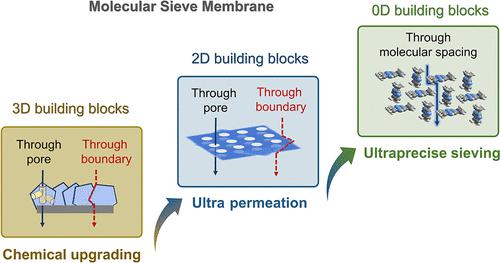当前位置:
X-MOL 学术
›
Acc. Chem. Res.
›
论文详情
Our official English website, www.x-mol.net, welcomes your
feedback! (Note: you will need to create a separate account there.)
Multidimensional Building Blocks for Molecular Sieve Membranes
Accounts of Chemical Research ( IF 16.4 ) Pub Date : 2022-10-21 , DOI: 10.1021/acs.accounts.2c00434 Yujie Ban 1, 2 , Weishen Yang 1, 2
Accounts of Chemical Research ( IF 16.4 ) Pub Date : 2022-10-21 , DOI: 10.1021/acs.accounts.2c00434 Yujie Ban 1, 2 , Weishen Yang 1, 2
Affiliation

|
Chemical separations aiming for high-purity commodities are critical to modern society. Compared to distillation, chemical absorption, and adsorption, membrane separation is attractive for its energy efficiency, ease of operation, and compact footprint. Molecular sieve membranes (MSMs) are broadly defined as membranes that are constructed from intrinsically and artificially porous materials. On the basis of our recent studies, this Account will first summarize the evolution of MSMs from the viewpoint of dimensionality of building blocks, which fundamentally determines the stacking architectures, intercrystalline gaps, and mass transfer channels of MSMs. Intergrowth of three-dimensional (3D) crystals as primary building blocks gives rise to classical MSMs. However, the poor connection between crystals inherent to those membranes results in intercrystalline gaps that are catastrophic for separation selectivity. We adopted a variety of strategies to close the crystal boundary gaps, including microwave synthesis, electrochemical–ionothermal synthesis, and modular integration. These efforts make us better understand the structure–performance relationship in membranes and create solutions for industrial processes. Excitingly, we first scaled-up the microwave synthesis of a Linde type A (LTA) zeolite membrane and built the world’s largest ethanol dehydration membrane unit with an annual capacity of 100,000 tons. MSMs can also be made of two-dimensional (2D) nanosheets as primary building blocks. Those strike a balance between permeation rate and selectivity because the nanometer thickness ensures the minimization of the mass-transfer resistance of the membrane and the layer-by-layer stacking mode can significantly reduce the intercrystalline gaps. By publishing our first report on metal–organic framework (MOF) nanosheet membranes in Science, we committed to establishing top-down and bottom-up methods for assembly of laminae. Once the stacking, orientation, and connection between the layers are meticulously controlled, nanosheet building blocks with diversity open the door for ultrapermeable and selective MSMs. We recently proposed a supramolecule array membrane (SAM) with zero-dimensional (0D) molecules as primary building blocks, which has great potential to absolutely eliminate intercrystalline gaps in membranes. In contrast to the classical transport through nanopores of membranes, selective transport through the intermolecular spacing of supramolecules is creatively realized within the SAM, which marks a new breakthrough in ultraprecise sieving of molecules with tiny differences in size and revolutionizes MSMs in regard to stacking modes, intercrystalline gaps, and transport channels. MSMs have proven to be successful in diverse applications and have triggered wide interest. A unique perspective on the dimensionality evolution of building blocks will accelerate the progress of MSMs. The synergy of multidimensional MSMs will be a positive response to fundamental bottlenecks and industrial questions of membranes and will unlock the potential of membranes to displace the existing separation technologies in the future.
中文翻译:

分子筛膜的多维构建模块
针对高纯度商品的化学分离对现代社会至关重要。与蒸馏、化学吸收和吸附相比,膜分离因其能效高、易于操作和占地面积小而具有吸引力。分子筛膜 (MSM) 被广泛定义为由固有和人工多孔材料构成的膜。本文将在近期研究的基础上,首先从结构单元维度的角度总结MSMs的演变,从根本上决定了MSMs的堆叠结构、晶间间隙和传质通道。三维 (3D) 晶体作为主要构建块的共生产生了经典的 MSM。然而,这些膜固有的晶体之间的不良连接会导致晶间间隙,这对分离选择性来说是灾难性的。我们采用了多种策略来缩小晶界间隙,包括微波合成、电化学-离子热合成和模块化集成。这些努力使我们更好地了解膜中的结构-性能关系,并为工业过程创造解决方案。令人兴奋的是,我们率先将林德A型(LTA)沸石膜的微波合成放大,建成了世界上最大的年产10万吨乙醇脱水膜装置。MSM 也可以由二维 (2D) 纳米片作为主要构建块制成。这些在渗透速率和选择性之间取得了平衡,因为纳米厚度确保了膜的传质阻力最小化,逐层堆叠模式可以显着减少晶间间隙。通过发表我们关于金属有机骨架 (MOF) 纳米片膜的第一份报告科学,我们致力于建立自上而下和自下而上的薄层组装方法。一旦层间的堆叠、方向和连接得到精心控制,具有多样性的纳米片结构单元就为超渗透性和选择性 MSM 敞开了大门。我们最近提出了一种以零维 (0D) 分子作为主要构建单元的超分子阵列膜 (SAM),它具有完全消除膜中晶间间隙的巨大潜力。与通过膜纳米孔的经典传输相比,在 SAM 中创造性地实现了通过超分子间距的选择性传输,这标志着在尺寸微小差异的分子超精密筛分方面取得了新突破,并在堆叠模式方面彻底改变了 MSM,晶间间隙,和运输渠道。MSM 已被证明在各种应用中是成功的,并引起了广泛的兴趣。对构建块的维度演化的独特视角将加速 MSM 的进步。多维MSM的协同作用将是对膜的基本瓶颈和工业问题的积极回应,并将释放膜在未来取代现有分离技术的潜力。
更新日期:2022-10-21
中文翻译:

分子筛膜的多维构建模块
针对高纯度商品的化学分离对现代社会至关重要。与蒸馏、化学吸收和吸附相比,膜分离因其能效高、易于操作和占地面积小而具有吸引力。分子筛膜 (MSM) 被广泛定义为由固有和人工多孔材料构成的膜。本文将在近期研究的基础上,首先从结构单元维度的角度总结MSMs的演变,从根本上决定了MSMs的堆叠结构、晶间间隙和传质通道。三维 (3D) 晶体作为主要构建块的共生产生了经典的 MSM。然而,这些膜固有的晶体之间的不良连接会导致晶间间隙,这对分离选择性来说是灾难性的。我们采用了多种策略来缩小晶界间隙,包括微波合成、电化学-离子热合成和模块化集成。这些努力使我们更好地了解膜中的结构-性能关系,并为工业过程创造解决方案。令人兴奋的是,我们率先将林德A型(LTA)沸石膜的微波合成放大,建成了世界上最大的年产10万吨乙醇脱水膜装置。MSM 也可以由二维 (2D) 纳米片作为主要构建块制成。这些在渗透速率和选择性之间取得了平衡,因为纳米厚度确保了膜的传质阻力最小化,逐层堆叠模式可以显着减少晶间间隙。通过发表我们关于金属有机骨架 (MOF) 纳米片膜的第一份报告科学,我们致力于建立自上而下和自下而上的薄层组装方法。一旦层间的堆叠、方向和连接得到精心控制,具有多样性的纳米片结构单元就为超渗透性和选择性 MSM 敞开了大门。我们最近提出了一种以零维 (0D) 分子作为主要构建单元的超分子阵列膜 (SAM),它具有完全消除膜中晶间间隙的巨大潜力。与通过膜纳米孔的经典传输相比,在 SAM 中创造性地实现了通过超分子间距的选择性传输,这标志着在尺寸微小差异的分子超精密筛分方面取得了新突破,并在堆叠模式方面彻底改变了 MSM,晶间间隙,和运输渠道。MSM 已被证明在各种应用中是成功的,并引起了广泛的兴趣。对构建块的维度演化的独特视角将加速 MSM 的进步。多维MSM的协同作用将是对膜的基本瓶颈和工业问题的积极回应,并将释放膜在未来取代现有分离技术的潜力。











































 京公网安备 11010802027423号
京公网安备 11010802027423号